SPECIFICATIONS
Part Number: 5441-419
Manufacturer: Woodward
Product type: ISO Relay Interface Module
Repair: 3-7 Days
Availability: In Stock
Country of Manufacture: United States (USA)
Functional Description
5441-419 is a 10 Amp ISO Relay Interface Module developed by Woodward. This module functions as a bridge, connecting intricate control systems to critical components, ensuring seamless communication and efficient operation. With testing and adherence to stringent standards, it ensures exceptional performance, even under demanding conditions, significantly enhancing the reliability and overall functionality of the systems it is incorporated into.
Features
- Bridging Control and Components: Conduit that links complex control systems to the essential components they oversee. This bridge ensures a seamless flow of information and control signals, enabling accurate and timely responses that are vital for the smooth operation of various processes.
- Reliability through Rigorous Testing: The module's reliability is a result of meticulous testing and quality assurance procedures. These rigorous assessments verify the module's performance under various scenarios, including challenging conditions. By undergoing such comprehensive testing, the module is poised to deliver consistent and dependable operation, even when faced with adverse environmental factors or demanding operational requirements.
- Adherence to Standards: Involves strict adherence to established industry standards. These standards set benchmarks for performance, safety, and compatibility. By conforming to these standards, the module guarantees compatibility with other components and systems, and ensures that it operates within prescribed parameters, further enhancing its reliability.
- Enhanced System Reliability: By playing a pivotal role in maintaining the communication and coordination between control systems and components, the module contributes significantly to the overall reliability of the systems it is integrated into. Its ability to facilitate accurate data transfer and control signals adds a layer of efficiency and dependability to diverse applications.
- Versatile Channel Configuration: With 16 channels, the module offers versatile connectivity options. These channels enable the module to connect to multiple devices or components, expanding its utility and applicability across a wide range of scenarios.
- Visual Feedback with LED Indication: The module features LED indicators that provide instant visual feedback. This real-time visibility into the status of individual channels simplifies monitoring, troubleshooting, and maintenance, contributing to efficient operations.
- Multi-Port Input for Enhanced Flexibility: Equipped with a 2-port input, the component adds an extra layer of flexibility to its functionality. This feature allows for expanded connectivity and the potential to interface with various input sources.
Relay Interface De-rating
- To ensure the safe and efficient operation of relay applications, it's crucial to establish an appropriate operating point. This involves a series of systematic steps that help determine the optimal conditions under which relays can function without exceeding critical temperature limits.
- Determine Maximum Simultaneously Energized Relays: Start by identifying the maximum number of relays that will be energized simultaneously for durations exceeding just a few minutes. This value serves as a fundamental parameter for establishing your operating point.
- Locate Diagonal Bold Lines on the De-Rating Chart: Refer to the provided de-rating chart and locate the diagonal bold lines that correspond to the number of relays "ON." Find lines that are both above and below your determined number of relays. These lines will form the foundation for your operating point determination.
- Horizontal Interpolation and Sketching: Interpolate horizontally between the identified diagonal lines. This process involves estimating the temperature values between the lines to define a boundary. Sketch a line that represents your interpolated value. You also have the option to round up your relay count to match an available line for simplicity.
- Determine Coil Voltage and Average Contact Current: Next, assess the supply voltage to the relay coils and calculate an average contact current. These parameters are essential for accurately defining your operating conditions.
- Find Corresponding Curves: On the de-rating chart, locate the curves that match your determined coil voltage. These curves represent different combinations of coil voltage and contact current, helping you visualize the operating limits for your application.
- Estimate Average Contact Current Curve: Estimate a curve that corresponds to your calculated average contact current. This curve should align with your application's parameters and the specific coil voltage you are using.
- Identify Intersection Point: The most critical step is identifying the intersection point between your estimated average contact current curve and the diagonal line representing the number of energized relays. This intersection point is the heart of your operating point determination.
- Check for Safe Temperature: The intersection point's temperature value must be below the critical limit of 55°C. This ensures that your relay application operates within a safe temperature range, preventing overheating and potential malfunctions.
World of Controls has the most comprehensive selection of GE and Woodward components. Our professionals are available to help you with your requirements at any time. If you require any additional information, please contact WOC immediately.
Frequently Asked Questions
What is 5441-419?
It is a ISO Relay Interface Module developed by Woodward.
Is de-rating necessary for all coil voltages and temperatures?
No, de-rating is not necessary for coil voltages of 24 Vdc and ambient temperatures below 47.5°C. Under these conditions, relays can be operated without reducing their capacity. However, higher coil voltages may require adjustments to prevent temperature issues.
What actions can be taken at higher coil voltages to manage temperature?
At higher coil voltages, options include reducing the number of energized relays or decreasing contact current. It's also possible to implement a combination of both strategies to ensure temperatures remain within acceptable limits.
What are the relay capabilities at 24 Vdc and ambient temperatures up to 55oC?
Relays can be energized at 24 Vdc and carry a maximum of 7 A at ambient temperatures up to 55oC when located outside the interface enclosure. This highlights their potential to handle demanding conditions while remaining effective.
